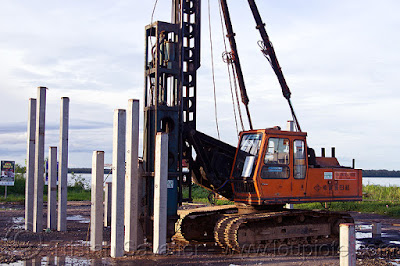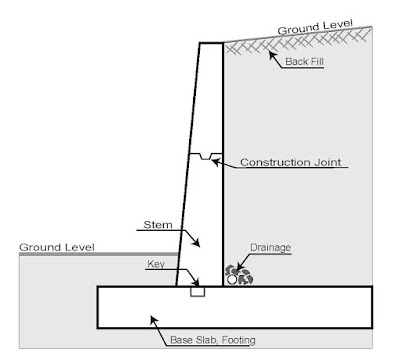Retaining Wall Design Consideration
Basic function of retaining wall is to retain soil at a slope which is greater than it would naturally assume, usually at a vertical or near vertical position. Retaining walls have primary function of retaining soils at an angle in excess of the soil’s nature angle of repose.
Walls within the design height range are designed to provide the necessary resistance by either their own mass or by the principles of leverage. During design stage, engineer must consider several important point which is vital and need to take account for such as ;
1. Overturning of the wall shall not occur
2. Forward sliding shall not occur
3. Materials to be used should be suitable and subject to availability
4. The subsoil will not overloaded
5. Nature and characteristics of the subsoil to be observed and examined very well
6. Height of water table.
The presence of water can create hydrostatic pressure, affect bearing capacity of the subsoil together with its shear strength, reduce the frictional resistance between the underside of the foundation
7. Type of wall to be construct.
Major Types of Retaining Walls
a) Mass retaining walls
Sometimes called gravity walls and rely upon their own mass together with the friction on the underside of the base to overcome the tendency to slide or overturn. Generally only economic up to 1.8 m. Mass walls can be constructed of semi-engineering quality bricks bedded in a 1:3 cement mortar or of mass concrete. Natural stone is suitable for small walls up to 1m high but generally it is used as a facing material for walls over 1 m
b) Cantilever walls
Usually of reinforced concrete and work on the principle of leverage where the stem is designed as a cantilever fixed at the base and the base is designed as a cantilever fixed at the stem. Economic height range of 1.2 m to 6 m using pre-stressing techniques. Any durable facing material can be applied to the surface to improve appearance of the wall
c) Counterfort retaining walls
Can be constructed of reinforced or prestressed concrete.Suitable for over 4.5 m.Triangular beams placed at suitable centres behind the stem and above the base to enable the stem and base to act as slab spanning horizontally over or under the counterforts
d) Precast concrete retaining walls
Manufactured from high-grade pre cast concrete on the cantilever principle.Can be erected on a foundation as permanent retaining wall or be free standing to act as dividing wall between heaped materials which it can increase three times the storage volume for any given area. Other advantages which is reduction in time by eliminating curing period, cost of formwork, time to erect and dismantle the temporary forms. Lifting holes are provided which can be utilized for fixing if required
e)
Precast concrete crib-retaining walls
Designed on the principle of mass retaining walls.A system of pre cast concrete or treated timber components comprising headers and stretchers which interlock to form a 3 dimensional framework or crib of pre cast concrete timber units within which soil is retained. Constructed with a face batter between 1:6 and 1:8. Subsoil drainage is not required since the open face provides adequate drainage.







